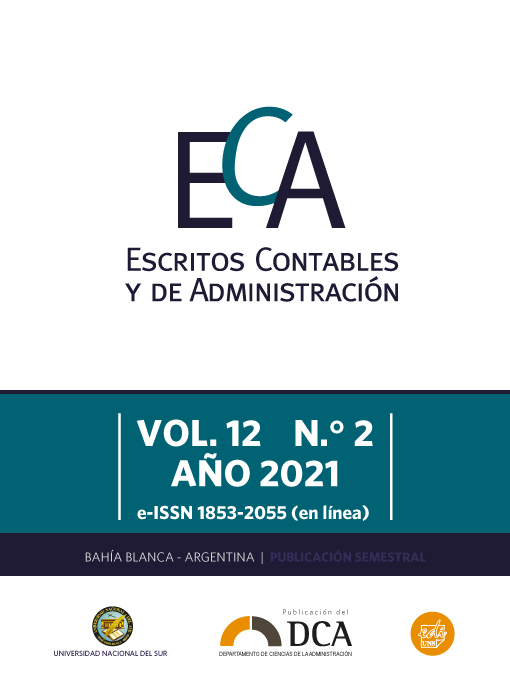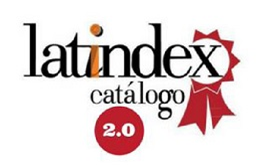Evaluación del valor de la tecnología de información (TI) en el sector público: un estudio entre Argentina y Brasil en el servicio de justicia federal
DOI:
https://doi.org/10.52292/j.eca.2021.2712Palavras-chave:
tecnología de la información , sector público , servicio de justiciaResumo
Con base en la teoría del ajuste de la tecnología a la tarea y la teoría de valor público, el presente trabajo aporta un modelo para evaluar el valor de la Tecnología de la Información (TI) en el sector público, desde la perspectiva de los usuarios internos. El modelo fue probado analizando la percepción de un grupo de empleados del servicio de justicia federal de Argentina y Brasil. Se optó por un enfoque de métodos mixtos, con dos etapas sucesivas de investigación (cualitativa y cuantitativa) y fuentes de evidencias primarias (entrevistas, observación, informantes clave, card sorting y encuestas). El estudio cualitativo permitió obtener el cuestionario a aplicar en la etapa cuantitativa de la investigación. Las cuatro proposiciones del modelo se reescribieron en términos de hipótesis y fueron confirmadas estadísticamente, usando modelado de ecuaciones estructurales con mínimos cuadrados parciales de regresión (PLS-SEM). La investigación contribuye a la academia al proponer un modelo para evaluar el valor de la TI en organizaciones públicas y en un área de aplicación específica, como el servicio de justicia. Se examinó la efectividad de dos Sistemas de Gestión de Expedientes Judiciales, mostrando así cómo se pueden evaluar implementaciones de TI en países en desarrollo. El valor práctico de esta investigación se basa en aclarar cómo la TI impacta en el desempeño de los empleados públicos y la calidad del servicio público.
Downloads
Referências
Andrade, A., & Joia, L. A. (2012). Organizational structure and ICT strategies in the Brazilian Judiciary System. Government Information Quarterly, 29(SUPPL. 1), S32-S42. https://doi.org/10.1016/j.giq.2011.08.003
Barbosa, A. F., Pozzebon, M., & Diniz, E. H. (2013). Rethinking E-government performance assessment from a citizen perspective. Public Administration, 91(3), 744–762. https://doi.org/10.1111/j.1467-9299.2012.02095.x
Barua, A., Kriebel, C. H., & Mukhopadhyay, T. (1995). Information technologies and business value: An analytic and empirical investigation. Information Systems Research, 6(1), 3-23. https://doi.org/10.1287/isre.6.1.3
Belanger, F., & Carter, L. (2012). Digitizing Government Interactions with Constituents: An Historical Review of E-Government Research in Information Systems. Journal of the Association for Information Systems, 13(5), 363-394. Retrieved from http://aisel.aisnet.org/jais/vol13/iss5/1
Bharati, P., & Berg, D. (2003). Managing information systems for service quality: A study from the other side. Information Technology & People, 16(2), 183-202. https://doi.org/10.1108/09593840310478685
Burton-Jones, A., & Grange, C. (2013). From Use to Effective Use: A Representation Theory Perspective. Information Systems Research, 24(3), 632-658. https://doi.org/10.1287/isre.1120.0444
Burton-Jones, A., & Straub, D. W. (2006). Reconceptualizing System Usage: An Approach and Empirical Test. Information Systems Research, 17(3), 228-246. https://doi.org/10.1287/isre.1060.0096
Busetti, S., & Vecchi, G. (2018). Process tracing change management: the reform of the Italian judiciary. International Journal of Public Sector Management, 31(5), 566-582. https://doi.org/10.1108/IJPSM-06-2017-0158
Carter, M., & Grover, V. (2015). Me, My Self, and I(T): Conceptualizing Information Technology Identity and Its Implications. MIS Quarterly, 39(4), 931–957.
Czepiel, J. A., Solomon, M. R., & Surprenant, C. F. (1985). The Service Encounter, Managing Employee/ Customer Interaction in Service Businesses. Lexington, MA: Lexington Books.
DeLone, W. H., & McLean, E. R. (2003). The DeLone and McLean Model of Information Systems Success: A Ten-Year Update. Journal of Management Information Systems, 19(4), 9-30. https://doi.org/10.1080/07421222.2003.11045748
Eisenhardt, K. M. (1989). Building Theories from Case Study Research. Academy of Management Review, 14(4), 532-550. https://doi.org/10.5465/amr.1989.4308385
Elena, S., & van Schalkwyk, F. (2017). Open Data for Open Justice in Seven Latin American Countries. In Achieving Open Justice through Citizen Participation and Transparency (Vol. i, pp. 210-231). https://doi.org/10.4018/978-1-5225-0717-8.ch011
Gomes, A. O., Alves, S. T., & Silva, J. T. (2018). Effects of investment in information and communication technologies on productivity of courts in Brazil. Government Information Quarterly, 35(3), 480-490. https://doi.org/10.1016/j.giq.2018.06.002
Goodhue, D. L. (1995). Understanding User Evaluations of Information Systems. Management Science, 41(12), 1827-1844. https://doi.org/10.1287/mnsc.41.12.1827
Goodhue, D. L., & Thompson, R. L. (1995). Task-Technology Fit and Individual Performance. MIS Quarterly, 19(2), 213-236. https://doi.org/10.2307/249689
Guimarães, T. de A., Odelius, C. C., Medeiros, J. J., & Vargas Santana, J. A. (2011). Management Innovation at the Brazilian Superior Tribunal of Justice. The American Review of Public Administration, 41(3), 297-312. https://doi.org/10.1177/0275074010380449
Hair, J. F., Hult, G. T. M., Ringle, C. M., & Sarstedt, M. (2017). A Primer on Partial Least Squares Structural Equation Modeling (PLS-SEM) (2nd ed.). Thousand Oaks, California: SAGE Publications, Inc.
Hays, J. M., & Hill, A. V. (2006). Service Guarantee Strength: The key to service quality. Journal of Operations Management, 24(6), 753-764. https://doi.org/10.1016/j.jom.2005.08.003
Heskett, J. L., Jones, T. O., Loveman, G. W., Sasser, W. E., & Schlesinger, L. A. (1994). Putting the service-profit chain to work. Harvard Business Review, 164-174.
Hsieh, J. J. P.-A., Rai, A., Petter, S., & Zhang, T. (2012). Impact of user satisfaction with mandated crm use on employee service quality. MIS Quarterly, 36(4), 1065-1080.
Joia, L. A. (2008). The impact of government-to-government endeavors on the intellectual capital of public organizations. Government Information Quarterly, 25(2), 256-277. https://doi.org/10.1016/j.giq.2007.06.004
Kearns, I. (2004). Public value and e-government. Institute for Public Policy Research. London: Institute for Public Policy Research. Retrieved from http://www.centreforcities.org/assets/files/pdfs/public_value_egovernment.pdf
Kim, D., & Ammeter, T. (2014). Predicting personal information system adoption using an integrated diffusion model. Information and Management, 51(4), 451-464. https://doi.org/10.1016/j.im.2014.02.011
Kositanurit, B., Ngwenyama, O., & Osei-Bryson, K.-M. (2006). An exploration of factors that impact individual performance in an ERP environment: an analysis using multiple analytical techniques. European Journal of Information Systems, 15(6), 556-568. https://doi.org/10.1057/palgrave.ejis.3000654
Kraemer, K. L., Danziger, J. N., Dunkle, D. E., & King, J. L. (1993). The Usefulness of Computer-Based Information to Public Managers. MIS Quarterly, 17(2), 129. https://doi.org/10.2307/249798
Kumar, R., Sachan, A., & Mukherjee, A. (2017). Qualitative approach to determine user experience of e-government services. Computers in Human Behavior, 71, 299-306. https://doi.org/10.1016/j.chb.2017.02.023
Luarn, P., & Huang, K.-L. (2009). Factors Influencing Government Employee Performance via Information Systems Use: an Empirical Study. Electronic Journal of E-Government, 7(3), 227-240. Retrieved from http://web.b.ebscohost.com/abstract?direct=true&profile=ehost&scope=site&authtype=crawler&jrnl=1479439X&AN=47435128&h=UNFktf5Kat81MgoTfscGax+2qb6UHkIFZZ3L4q4z9cWKKufr9E8tYKqM2wV22v6r+TadRVoP7Ejr1qgE2ElncA==&crl=c&resultNs=AdminWebAuth&resultLocal=
Luzuriaga, J. M., & Cechich, A. (2011). Electronic notification of court documents. In Proceedings of the 5th International Conference on Theory and Practice of Electronic Governance - ICEGOV ’11 (p. 45). New York, New York, USA: ACM Press. https://doi.org/10.1145/2072069.2072077
Moore, G. C., & Benbasat, I. (1991). Development of an Instrument to Measure the Perceptions of Adopting an Information Technology Innovation. Information Systems Research, 2(3), 192-222. https://doi.org/10.1287/isre.2.3.192
Moore, M. H. (1995). Creating Public Value: Strategic Management in Government. Harvard University Press. Retrieved from https://books.google.com.ar/books?id=Hm9uKVj0qDYC
Muslimin, I., Hadi, S. P., & Nugroho, E. (2017). An Evaluation Model Using Perceived User Technology Organization Fit Variable for Evaluating the Success of Information Systems. Scientific Journal of Informatics, 4(2), 86-94.
Myers, M. D. (1997). Qualitative Research in Information Systems. MIS Quarterly, 21(2), 241–242. Retrieved from http://www.misq.org/skin/frontend/default/misq/MISQD_isworld/ index.html
Nahm, A. Y., Rao, S. S., Solis-Galvan, L. E., & Ragu-Nathan, T. S. (2002). The Q-Sort Method: Assessing Reliability And Construct Validity Of Questionnaire Items At A Pre-Testing Stage. Journal of Modern Applied Statistical Methods, 1(1), 114-125. https://doi.org/10.22237/jmasm/1020255360
Nieves, J., & Osorio, J. (2019). Using information technology to achieve management innovation. Academia Revista Latinoamericana de Administración, 32(1), 20-39. https://doi.org/10.1108/ARLA-02-2016-0037
Pang, M.-S., Lee, G., & DeLone, W. H. (2014). In public sector organisations: a public-value management perspective. Journal of Information Technology, 29(3), 187-205. https://doi.org/http://dx.doi.org/10.1057/jit.2014.2
Procopiuck, M. (2018). Information technology and time of judgment in specialized courts: What is the impact of changing from physical to electronic processing? Government Information Quarterly, 35(3), 491-501. https://doi.org/10.1016/j.giq.2018.03.005
Raine, J. W. (2000). Modernising courts or courting modernisation? International Journal of Public Sector Management, 13(5), 390-416. https://doi.org/10.1108/09513550010350788
Sandoval-Almazan, R., & Gil-Garcia, J. R. (2018). Understanding e-Justice and Open Justice Through the Assessment of Judicial Websites. Social Science Computer Review, (100), 089443931878595. https://doi.org/10.1177/0894439318785957
Sarstedt, M., Ringle, C. M., & Hair, J. F. (2017). Partial Least Squares Structural Equation Modeling. In Handbook of Market Research (pp. 1-40). Cham: Springer International Publishing. https://doi.org/10.1007/978-3-319-05542-8_15-1
Serrano, C., & Karahanna, E. (2016). The Compensatory Interaction Between User Capabilities and Technology Capabilities in Influencing Task Performance: An Empirical Assessment in Telemedicine Consultations. MIS Quarterly, 40(3), 597-621.
Silva, R. A. F., Guimarães, T. de A., & Sousa, M. M. (2019). What judges think about the meaning of their work. International Journal for Court Administration, 10(1), 59. https://doi.org/10.18352/ijca.258
Sousa, M. de M., & Guimarães, T. de A. (2017). The adoption of innovations in Brazilian labour courts from the perspective of judges and court managers. Revista de Administração, 52(1), 103-113. https://doi.org/10.1016/j.rausp.2016.09.008
Stake, R. E. (2005). Qualitative Case Studies. In N. K. Denzin & Y. S. Lincoln (Eds.), The Sage Handbook of Qualitative Research (pp. 443-466). Thousand Oaks, CA: Sage Publications Ltd.
Sun, H., Fang, Y., & Zou, H. (Melody). (2016). Choosing a Fit Technology: Understanding Mindfulness in Technology Adoption and Continuance. Journal of the Association for Information Systems, 17(6), 377-412. Retrieved from http://aisel.aisnet.org/jais/vol17/iss6/2
Torkzadeh, G., & Doll, W. J. (1999). The development of a tool for measuring the perceived impact of information technology on work. Omega, 27(3), 327-339. https://doi.org/10.1016/S0305-0483(98)00049-8
Velicogna, M., Steigenga, E., Taal, S., & Schmidt, A. (2020). Connecting EU Jurisdictions: Exploring How to Open Justice Across Member States Through ICT. Social Science Computer Review, 38(3), 274–294. https://doi.org/10.1177/0894439318786949
Venkatesh, V., Brown, S. A., & Bala, H. (2013). Bridging the qualitative–quantitative divide: guidelines for conducting mixed methods research in information systems. MIS Quarterly, 37(3), 855-879.
Venkatesh, V., Brown, S., & Sullivan, Y. (2016). Guidelines for Conducting Mixed-methods Research: An Extension and Illustration. Journal of the Association for Information Systems, 17(7), 435-494. Retrieved from http://aisel.aisnet.org/jais/vol17/iss7/2
Venkatesh, V., Thong, J., & Xu, X. (2016). Unified Theory of Acceptance and Use of Technology: A Synthesis and the Road Ahead. Journal of the Association for Information Systems, 17(5). Retrieved from http://aisel.aisnet.org/jais/vol17/iss5/1
Yin, R. K. (2001). Estudo de caso: planejamento e métodos (2a). Porto Alegre: Bookman.
Publicado
Como Citar
Edição
Seção
Licença
Copyright (c) 2021 María Isabel Arias

Este trabalho está licenciado sob uma licença Creative Commons Attribution-NonCommercial 4.0 International License.
Aviso de derechos de autor
Aquellos autores/as que tengan publicaciones con esta revista, aceptan los términos siguientes:
- Los autores/as conservarán sus derechos de autor y garantizarán a la revista el derecho de primera publicación de su obra, el cual estará simultáneamente sujeto a la licencia Atribución-No Comercial 4.0 Internacional CC BY-NC 4.0.
- Los autores/as podrán adoptar otros acuerdos de licencia no exclusiva de distribución de la versión de la obra publicada (p. ej.: depositarla en un archivo telemático institucional o publicarla en un volumen monográfico) siempre que se indique la publicación inicial en esta revista.
- Se permite y recomienda a los autores/as difundir su obra a través de Internet (por ej.: en páginas web institucionales o personales) una vez publicado su trabajo, lo cual puede producir intercambios interesantes y aumentar las citas de la obra publicada (Véase El efecto del acceso abierto).





















